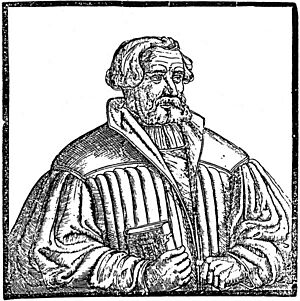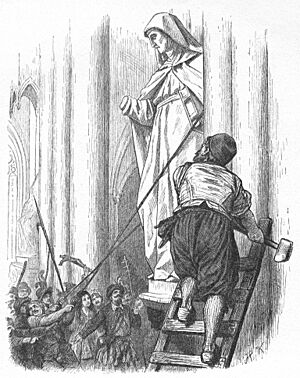Andreas Karlstadt facts for kids
Quick facts for kids
Andreas Karlstadt
|
|
|---|---|

Andreas Bodenstein von Karlstadt, portrait 1541/42
|
|
| Born | 1486 Karlstadt, Bishopric of Würzburg
|
| Died | 24 December 1541 (aged 55) Basel, Canton of Basel, Swiss Confederation
|
| Occupation | Theologian |
| Theological work | |
| Era | Protestant Reformation |
Andreas Rudolph Bodenstein von Karlstadt (1486–24 December 1541) was a German Christian thinker and an early leader of the Protestant Reformation. He is better known as Andreas Karlstadt. He was a professor and chancellor at the University of Wittenberg. Karlstadt was a friend and colleague of Martin Luther at the start of the Reformation.
Karlstadt became one of the first people to support Luther's ideas. When Luther was hidden away in Wartburg Castle (1521–1522), Karlstadt and Thomas Müntzer began a movement to remove religious statues and images from churches. They also taught ideas that some people later linked to the Anabaptist movement. However, Karlstadt and Müntzer never saw themselves as Anabaptists.
Karlstadt was a church reformer who often worked on his own. He later disagreed with Luther and joined the Reformed tradition. He even became a more radical reformer for a time. Towards the end of his life, he worked with Heinrich Bullinger in Switzerland and lived in Basel, where he passed away. Even though he grew closer to the Reformed tradition, Karlstadt kept his own unique ideas on many religious topics throughout his life.
Contents
Becoming a Scholar
Andreas Karlstadt studied at several universities. He went to Erfurt from 1499 to 1503. Then he studied in Cologne from 1503 to 1505.
He earned his master's degree from the new University of Wittenberg in 1505. Five years later, in 1510, he received his doctorate in theology from the same university.
In 1510, Karlstadt became a senior church official called an archdeacon. He also became the head of the theology department. By 1511, he was the chancellor of Wittenberg University. He even awarded Martin Luther his doctorate in 1512. From 1515 to 1516, Karlstadt studied in Rome. There, he earned two degrees in church law and civil law.
The Start of the Reformation
Before 1515, Karlstadt followed a traditional way of thinking in theology. He was a priest who was not part of a monastery. His views changed after he visited Rome. He said he saw a lot of corruption in the Catholic Church there.
On September 16, 1516, Karlstadt wrote 151 statements or "theses." These were his ideas for church reform. They are different from Luther's famous 95 theses, which came later.
In 1519, a scholar named Johann Eck challenged Karlstadt to a public debate. This was known as the Leipzig Debate. Martin Luther also took part in this important discussion.
On June 15, 1520, Pope Leo X issued an official order called a papal bull. This order, named Exsurge Domine, threatened Luther and Karlstadt with being kicked out of the church. It also said some of their ideas were wrong. Both reformers stood firm. So, in 1521, they were officially excommunicated from the Catholic Church.
After the Diet of Worms in 1521, Luther went into hiding. Karlstadt then worked to bring changes to Wittenberg. On Christmas Day 1521, he led the first "reformed" communion service.
He made several changes to the traditional Mass. He did not lift the bread and wine during the service. He wore regular clothes instead of special church robes. He also removed any mention of sacrifice from the Mass. Instead of whispering the special words, he said them loudly in German. He also said people did not need to confess their sins before taking communion. And he let people take both the bread and wine themselves.
In early 1522, the Wittenberg city council allowed images to be removed from churches. They also approved Karlstadt's changes to the communion service. Karlstadt wrote a paper called "On the Removal of Images" that year. On January 19, Karlstadt married Anna von Mochau. She was the 15-year-old daughter of a poor nobleman.
However, on January 20, the government and the Pope ordered Frederick the Wise to reverse these changes. Frederick allowed most of the Mass to return to its Catholic form. But he showed some sympathy for Karlstadt in a letter.
Karlstadt and Luther's Relationship
In early March, Luther returned from Wartburg. From March 9 to 16, Luther gave eight sermons. In these talks, he agreed with some of Karlstadt's ideas. But he also told people to be careful and not rush into changes. This was a major turning point between Karlstadt and Luther.
Karlstadt became more focused on spiritual experiences. He started wearing simple peasant clothes. He asked people to call him "Brother Andreas." He also grew tired of academic life. He even gave up his three doctoral degrees.
In May 1523, the church in Orlamünde invited Karlstadt to be its pastor. He accepted right away. There, he put all his radical reforms into practice. Orlamünde became an example of a church run by its members. Church music and art were removed. He preached that priests should be allowed to marry. He also rejected the idea of infant baptism. Most importantly, in Orlamünde, Karlstadt taught that Christ was spiritually, but not physically, present in communion.
From spring 1524, Luther began to speak out against Karlstadt. Luther tried to stop Karlstadt from publishing or preaching without his permission. In June, Karlstadt resigned as archdeacon. In July, Luther wrote a letter to the Saxon princes. In it, he claimed that Thomas Müntzer and Karlstadt were dangerous troublemakers. Karlstadt believed that Christians should observe the Sabbath, the seventh day of the week, as a holy day. Luther disagreed, saying Christians were free to observe any day. Because Karlstadt defended the Sabbath, some people called him a Jew and a heretic.
On August 22, 1524, Luther preached in Jena. Karlstadt was in the crowd and later asked to see Luther. This led to a famous meeting at the Black Bear Inn. There were many misunderstandings between them. For example, Luther thought Karlstadt wanted a revolution. But Karlstadt had always rejected violence for religious reasons. He had also refused to join Thomas Müntzer's group. Karlstadt published his side of the story in 1524. This showed that he continued to reject the violence that led to the German Peasants' War. Luther also wrongly accused Karlstadt of not having permission to preach in Wittenberg while Luther was at Wartburg. The meeting ended when Luther gave Karlstadt money and told him to write against him. In September 1524, Karlstadt was sent away from Saxony. Luther also wrote against Karlstadt in his 1526 book, The Sacrament of the Body and Blood of Christ—Against the Fanatics.
Peasant War and Exile
When the German Peasants' War began, Karlstadt felt threatened. He wrote to Luther and asked for help. Luther took him in, and Karlstadt secretly lived in Luther's house for eight weeks. However, Karlstadt had to sign a statement saying he was sorry for his actions. This statement was called "Apology by Dr. Andreas Karlstadt Regarding the False Charge of Insurrection." Luther also wrote a short introduction for it. In March, Luther's wife, Katharina von Bora, became godmother to one of Karlstadt's children. Karlstadt was not allowed to preach or publish. He supported his family by working as a farmer and a traveling seller near Wittenberg until 1529.
Removing Images from Churches
Some Protestant reformers, especially Andreas Karlstadt, Huldrych Zwingli, and John Calvin, encouraged removing religious images. They believed these images went against the Ten Commandments' rule against worshipping idols. As a result, religious statues and pictures were destroyed. This happened in sudden individual attacks and in riots.
A scholar named Erasmus described one such riot in Basel in 1529. He wrote that people insulted images of saints and even the crucifix. He said it was surprising no miracle happened to stop them. Not a single statue was left in churches or monasteries. Paintings were covered with white paint. Anything that could burn was set on fire, and the rest was smashed. Nothing was saved.
Karlstadt was strongly linked to this "image storm" or Bildersturm. In 1522, he convinced the Wittenberg Council to order the removal of images from local churches. This had serious consequences. Martin Luther disagreed with these actions. On March 12, 1522, Karlstadt spoke about pictures of Mary, which people worshipped at the time. He urged that all such images be removed. He especially targeted images of Mary visited during pilgrimages. He also called for the removal of all public religious images and symbols. He asked for the destruction of shrines dedicated to Mary. Karlstadt was supported by Martin Bucer, Huldrych Zwingli, and John Calvin.
This movement was not just in Germany. Major image-destroying riots happened in Zürich (1523), Copenhagen (1530), Münster (1534), Geneva (1535), Augsburg (1537), and Perth (1559). The Seventeen Provinces (now the Netherlands and Belgium) saw a huge wave of Protestant image destruction in the summer of 1566. In the Netherlands, this event is called the "Beeldenstorm". It started with the destruction of images in the Monastery of Saint Lawrence in Steenvoorde. This happened after a sermon by Sebastiaan Matte. The Monastery of Saint Anthony was also attacked after a sermon by Jacob de Buysere. The "Beeldenstorm" is often seen as the start of the Dutch Revolt against the rulers of the Netherlands.
Later Life and Death
After leaving Saxony, Karlstadt worked as a minister in Switzerland. He served in Altstätten and Zürich. In 1534, he moved to Basel. There, he became a minister at the university church. He also became a professor of Hebrew and the dean of the university. He stayed in Basel until he died from the plague on December 24, 1541.
Karlstadt published about 90 writings during his lifetime. These were released in about 213 different editions. Between 1518 and 1525, 125 editions of his works were published in Germany. This was more than any other writer except Luther. Karlstadt's ideas were similar to many later Anabaptist views. His books about the Lord's Supper were published with help from the Swiss Brethren in Zürich. These included Felix Mantz and probably Andreas Castelberg. His brother-in-law, Gerhard Westerburg of Cologne, also helped. Westerburg baptized over 2,000 adults in his swimming pool.
Karlstadt had a big impact on Protestantism. He helped end the rule that priests could not marry. He married more than three years before Luther. He also wrote several books on the topic of marriage for clergy. His ideas about images and church services directly influenced Zwingli and the Anabaptists. He also indirectly influenced Baptists and Presbyterian Protestants. He greatly influenced Melchior Hoffman, who spread Anabaptist ideas to northern Germany and the Netherlands. In Amsterdam, the founders of the English Baptists, John Smyth and Thomas Helwys, adopted key teachings from the Waterlander Mennonites.
Works
- On the Canon of Scripture (in Latin, 1520; in German, 1521-2)
- On the Removal of Images [1] (Wittenberg 1522)
- On Baptism (Worms 1527)
- Letter from the Community of Orlamünde to the people of Allstedt, on how Christians ought to fight., (Wittenberg: 1524).
Images for kids



